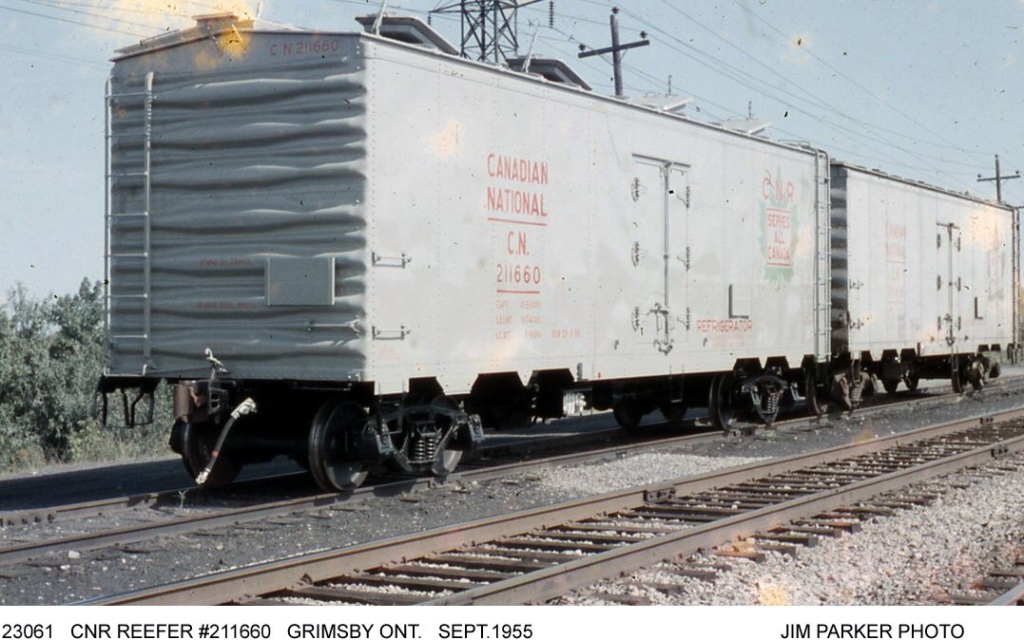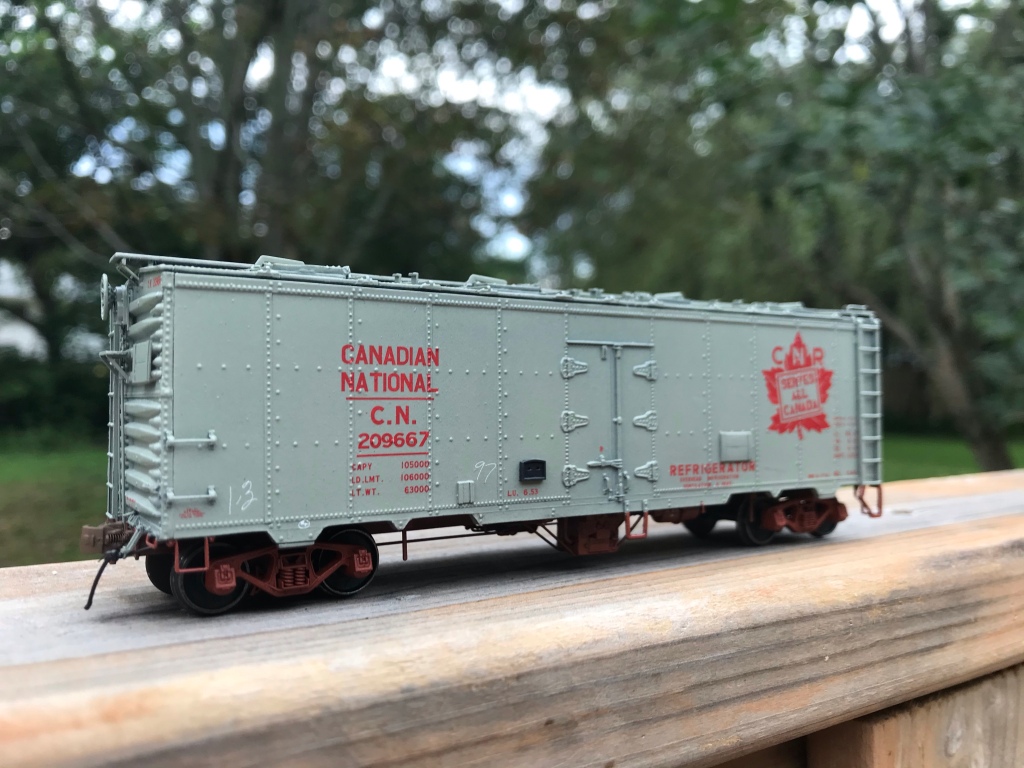As my modelling slowly starts to ramp up again, there isn’t much content for me to post. However, I realized that the projects I completed before this blog’s existence are not yet documented here. I thought it might be fun to fill in the slow times with what I’m going to call a BUILD RUN-DOWN. I felt the right place to start would be with a Funaro & Camerlengo CNR 8-Hatch Reefer kit I built a couple years back.

Between 1939 and 1958, the CNR had built for it over 3000 8-hatch steel reefer cars. F&C has built flat resin kits to represent these cars for 20+ years. I have a handful of the True Line Trains ready to run models, but I wanted to paint one up with the red maple leaf and #11 red under-frame.

The kit was built, mainly adhering to the included instructions. However, I provided some enhancements by upgrading and adding a few details. (I will provide a parts list at the end of the post.)
Construction began by cleaning up all of the flat kit castings and giving them a bath in Dawn Dish Soap to remove any mold release agent.
The truck bolsters on the car’s under-frame were then drilled and tapped, and the same for the couplers. At this point, while the kit was still flat, I drilled out most of the holes required for grab irons, eye bolts and the heater pipes. However, some of the holes were left undrilled until the body was assembled to ensure their placement would be accurate.
Once I was satisfied that I had removed all of the flash and mold release agents from the parts, I used 1-2-3 blocks, tape, patience and a minimum initial amount of CA to assemble the flat car sides, ends and roof into a 3D body shell. At this point, I turned my attention to the under-frame.

I used various sizes of Tichy phosphor bronze wire for the brake rigging. My standard approach for this is to use .015,” or .020″ wire for the train line (if I include it), .0125″ wire for the brake rods, .010″ wire for the air-lines and .008 wire for the retainer line and release rod, the latter which I usually wait and add after the model has been fully painted and the underframe has been glued in place. Tichy turnbuckles cut in half were used to simulate the Yarmouth Model Works brake levers’ clevis. The piping going to and from the underslung heater was added with piano wire. (In hindsight, you may have better luck with some Tichy .038″ PB wire as cutting piano wire this thick was NOT fun. I eventually had to use aviation snips.)

Once I was happy with the underframe, I moved to the car body. As I mentioned above, I adhered mainly to the kit’s instructions, so I won’t bother getting too detailed. However, I will say out of all of the upgraded detail parts I used, I think the Des Plaines Hobbies Canadian Style 8 Rung Ladders and Yarmouth Model Works running boards made the most significant visual difference; I can’t recommend these parts enough for your next Canadian prototype build.

The hatch rests, tack + defect boards, brake wheel mount and jacking pads were built with Evergreen strip styrene. This was all pretty straight forward except for the hatch rests. The hatch rests included with the kit left a lot to be desired, so I used a tip I read on Pierre Oliver’s blog and made them out of strip styrene. A strip of 1×3″ and 1×6″ styrene was glued together in an “L” shape, which I then cut to equal sizes with my NWSL Chopper II. To have the hatch rests appropriately centred on the model’s roof, I laid out strips of masking tape on my workbench. I measured out the proper distances and drew lines on the tape to use as a guide, then taped the strips to the roof of the model and glued the hatch rests on with CA using the tape lines as a guide.
I primed the car with Tamiya Fine Surface primer- the bottom section of the car got primed with Oxide Red while the body got primed with Grey. I then loaded up my airbrush with black paint (VMA 71.057) and pre-shaded all of the panel lines, grab irons, brake rigging, running boards— virtually anything I wanted to stand out. I then painted the model, as usual, allowing the pre-shading to very lightly appear through the paint. The car’s bottom was painted #11 Red while the body was painted #11 Grey and all paints were Vallejo Model Air. To get #11 Red, I mixed 2pt VMA 71.105 to 1pt 71.038. For #11 Grey, I used straight VMA 71.045. After the model was painted, I used a #0 brush to paint anything attached to the body but falling under the sill (such as grab irons, stirrup steps etc.) #11 Red.

Before lettering the car, I sprayed it with Testors Glosscoat and allowed it to cure for four days. The car was lettered with Black Cat Decals [CNR#209710-H] instead of the ones included. I also had some Speedwitch Media freight car chalk markings (highly recommended), which I later added. To get the particular car number and correct data information I wanted onto the model, I had to do some surgery on the decals. I wound up placing a lot of the numbers individually, which was time-consuming. After lettering was finished, the car was again sprayed with Glosscoat followed by Dull coat and allowed to cure.


All in all, I was very satisfied with how this model turned out. I gained a lot of experience and tried many new-to-me techniques.
Next time I’ll be giving a rundown on a Yarmouth Model Works 40ft CNR boxcar I completed a year ago.
Thanks for reading!
CM
COMMERCIAL DETAIL PARTS USED:
- “HO Canadian 8 Rung Ladders” / Des Plaines Hobbies [DPH-2003] x1 Package
- Laser Cut 40′ Wood Running Board w/ Laterals & Etched Brackets / Yarmouth Model Works [YMW-255] x1 Package
- “Eyebolt No Collar” / Yarmouth Model Works [YMW-500] x1
- “Eyebolt w/ Collar” / Yarmouth Model Works [YMW-501] x1
- “Bracket Grab Drilling Template” / Yarmouth Model Works [YMW-502] x1
- “Brake Levers, Set of 10” / Yarmouth Model Works [YMW-503] x1
- “AB Brake Set” / Tichy Train Group [#3013] (included w/ kit) x1
- “Turnbuckles” / Tichy Train Group [#8021] x1 Package
- “Straight Side Mount (Stirrup)” / Tichy Train Group [#3038] (included w/ kit) x1 Package (Tip: After all of my upgrades, I do find these are left looking a little out of scale. Perhaps an A-Line product would have been better suited.)
- “HO 22” A.A.R. Air Hoses w/Brass Brackets” / Hi-Tech Details [HTD-6040] x1 Package
- “HO Blackened Brass Chain / 45 Links Per Inch” – Crescent Locomotive Works (eBay seller)
- “Barber S-2 50-Ton Trucks” / Tahoe Model Works [TMW-213] x1 Pair
- “Semi-Scale .88 Wheels” / Intermountain Railway Company (came w/ trucks) x4
- “Scale Whisker Metal Couplers Med Centerset Shank” / Kadee Quality Products Co [#178] x2
- “Side Grab Irons – Red Oxide” / Kadee Quality Products Co [#2250]
- “Scale Snap-Together Gearboxes and lids” / Kadee Quality Products Co [#178] x2
- “Westinghouse Single Pressure Retainer Valves” / Precision Scale Co [#3263] x1
- DECALS:
- “CNR 8 hatch reefer leaf scheme 1953-1961” / Black Cat Decals [CNR#209710-H]
- “Freight Car Chalk Markings” / Speedwitch Media [D135]
SCRATCH-BUILT PARTS USED:
- Hatch Rests x16 – Scale strip styrene cut with a chopper tool and glued together in “L” shape
- Defect Boards x2 – Scale strip styrene cut and assembled
- Tack Boards x4 – Scale strip styrene cut and assembled
- Drain Spouts x4 – Tichy PB wire inserted into holes drilled into car bottom and glued from the inside. Square styrene strip cored out with a pin vice and then slid over the PB wire, dab of CA secures the styrene to the bottom of the car and wire.
- Brake Lines – .010 Tichy PB wire measured, cut to size, bent with pliers, inserted and glued into brake components.
- Brake Rods – .0125 Tichy PB wire cut to size and inserted into Tichy turnbuckles which were cut in half and thinned down to simulate the clevis.
- Coupler Cut Levers x2 – .008 Tichy PB wire cut and bent to shape. Inserted through bracket on car end and through YMW “Eyebolt No Collar” above coupler.
- Release Rod x1 – .008 Tichy PB wire cut and bent to shape. Inserted through hole drilled into sill and through YMW “Eyebolt No Collar”, drilled and inserted into triple valve.
- Stand-offs for DPH 8 Rung Ladders x8 – Strip styrene cut and glued to ladders, then ladder glued to car.
- Underslung Heater Piping x2 – Music wire cut, bent and inserted through holes drilled into the sides of the underslung heater casting and through holes drilled into the car floor. Glued from the inside of the car with JB Weld 2-Part Epoxy (the 15-Minute stuff)



